
Barcelona
A Mediterranean port city tucked among the hills of Spain’s northeastern coastline, Barcelona’s corridors of winding streets speak to more than a millennium of history. Yet, with a lively culinary and bar scene, and displays of modern fashion and politically charged graffiti, the Catalonian capital’s charm comes from the vibrance of constantly juxtaposing the old and new.
My husband Stephen and I arrived in Barcelona on a Saturday night in early August and were quickly introduced to the rhythms of Spanish life. We rented a room in a flat in the Barri Gòtic neighborhood near the sea. Having dragged our bags more than a mile along the city’s cobbled streets and then taken a five-floor walk-up, we were ready for sleep when we reached our room. For the rest of Barcelona, however, the night was just beginning. Our temporary flatmate, an Argentinean student on vacation, politely waited to let us into the apartment before joining half a dozen friends for a night on the town. While we put our explorations off until the morning, we drifted off to the lull of a city very much awake around us.
After a needed night’s sleep, our friends Alex Gomez-del-Moral and Kat Mahaney met us at our flat and offered an ideal introduction to the city. Alex and Kat are both historians of Spain, and, lucky for Stephen and me, our three-day trip to Barcelona happened to intersect with their month of research and writing. Alex, who has dual Spanish and American citizenship, was especially helpful when it came to navigating Spanish menus because he can converse in not only Spanish, but also in the region’s native Catalan.
Those traveling without a friend and translator would find a Spanish restaurant card helpful. That said, Spain is well-equipped for gluten-free dining. The Federación de Asociaciones de Celíacos de España (FACE) has created a nationwide “Contrato por FACE” labeling system. Even when dining without Alex’s assistance, our waiters were familiar with gluten-free dining and helped us navigate the menu. Many of the country’s staples – like padrón peppers, delicious cheeses, chorizo, and tortilla (or Spanish omelet) – are naturally gluten-free, easing the potential stress of dining out. One of my favorite things about traveling in Spain is the gluten-free section at the country’s signature department store,El Corte Inglés. They carry all manner of gluten-free breads, pastries, and other treats, including a chocolate croissant.
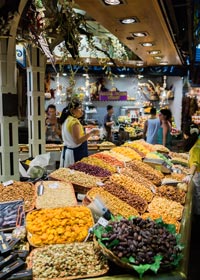 In the light of our first morning, Barcelona’s labyrinth of streets became all the more apparent. It is a city of neighborhoods, each with its own character, and yet they are concentrated together into a kind of tight-knit patchwork. Barri Gòtic had a medieval character revealed in narrow roads lined with tall, stone buildings. Yet we were only a few blocks from La Ramblas, a wide pedestrian street often crowded with shoppers and diners that speaks to nineteenth century European design. Its eclectic qualities make spending a day wandering the city an event in and of itself – and that’s precisely what we set out to do.
In the light of our first morning, Barcelona’s labyrinth of streets became all the more apparent. It is a city of neighborhoods, each with its own character, and yet they are concentrated together into a kind of tight-knit patchwork. Barri Gòtic had a medieval character revealed in narrow roads lined with tall, stone buildings. Yet we were only a few blocks from La Ramblas, a wide pedestrian street often crowded with shoppers and diners that speaks to nineteenth century European design. Its eclectic qualities make spending a day wandering the city an event in and of itself – and that’s precisely what we set out to do.
But first, breakfast. Spanish dining incrementally expands throughout the day. You don’t order an entrée in Spain, but eat from a range of small plate items, known as tapas, which the table shares. Meals start small early in the day, with evening meals offering a larger number of options. While lunch and dinner include plenty of gluten-free items, breakfast can be more challenging. I generally travel with granola bars and a jar of peanut butter on hand, which came in handy that first morning. Fortunately, a good cappuccino is never far away in Spain. I happily sipped one as my companions indulged in some of Spain’s signature pastries.
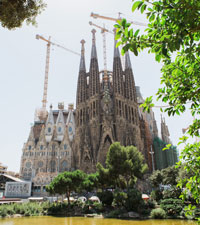 As we proceeded into the city, the art nouveau styling of Catalonia’s signature architect Antoni Gaudí guided our path. Since the late-nineteenth century, Barcelona has been deeply impacted by the whimsical styling of Gaudí’s molded, tiled, and often brightly colored designs – all indicative of Catalonia’s El Modernisme movement. With Kat and Alex as our guides, we took the metro further into Barcelona’s interior and made our way up the hills to Parque Güell, a garden suburb where Gaudí’s designs shape a distinct, wavy pattern of tiles throughout. Starting at the top, we descended into the palm-treestyled corridors of Gaudí’s creation and then out onto the plaza made famous for its mosaic dragon (an ongoing motif that references Catalonia’s dragon-slaying patron St. George).
As we proceeded into the city, the art nouveau styling of Catalonia’s signature architect Antoni Gaudí guided our path. Since the late-nineteenth century, Barcelona has been deeply impacted by the whimsical styling of Gaudí’s molded, tiled, and often brightly colored designs – all indicative of Catalonia’s El Modernisme movement. With Kat and Alex as our guides, we took the metro further into Barcelona’s interior and made our way up the hills to Parque Güell, a garden suburb where Gaudí’s designs shape a distinct, wavy pattern of tiles throughout. Starting at the top, we descended into the palm-treestyled corridors of Gaudí’s creation and then out onto the plaza made famous for its mosaic dragon (an ongoing motif that references Catalonia’s dragon-slaying patron St. George).
From there, we moved into the center of Barcelona to take in La Sagrada Família, Barcelona’s expansive basilica, which has been under construction since 1882. The church remains Gaudí’s signature work in the city. Its narrow towers look as though they’re dripping, reminding me of a vast sand castle. After taking in the exterior of the church, we proceeded along Carrer Provença into the upscale neighborhood of Vila de Gràcia. There we found Gaudí’s Casa Milà, also known as La Pedrera. The fantastical quality of its facade includes sloping edges and bonelike, foreboding window trimmings. Today it appropriately serves as a cultural center.
If one is not familiar with the distinctive qualities of Catalonian culture and politics, Gaudí provides a useful introduction. Since the late-nineteenth century, his work has participated in the growth of a distinctive national identity that continues to energize the Catalan independence movement. Walking down Barcelona’s streets, yellow flags with a star and red stripes hang from balconies – all signs of the Catalan desire to break away from Spain. As the Spanish economy flounders, Barcelona has been especially hard hit, further fueling the region’s push for independence. Considering this instability, one is well-advised to be mindful of their belongings, especially in crowded shopping areas, as pick pocketing is prevalent.
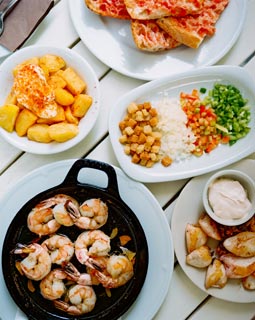 The effects of Spain’s slowed economy are less apparent, however, along the fashionable streets of Vila de Gràcia. We grabbed an outdoor table in the shade at Costa Gallega Moncho’s and proceeded to eat our way through a delicious selection of tapas. Our walk across much of the city had me pretty hungry, so in addition to the shrimp, squid and patatas bravas, I had a tortilla. Loaded with eggs, potatoes and olive oil, it provided ample gluten-free fuel to continue our exploration.
The effects of Spain’s slowed economy are less apparent, however, along the fashionable streets of Vila de Gràcia. We grabbed an outdoor table in the shade at Costa Gallega Moncho’s and proceeded to eat our way through a delicious selection of tapas. Our walk across much of the city had me pretty hungry, so in addition to the shrimp, squid and patatas bravas, I had a tortilla. Loaded with eggs, potatoes and olive oil, it provided ample gluten-free fuel to continue our exploration.
Since Spaniards go for a late dinner – around 10 pm – we grabbed a late afternoon snack and I had a refreshing Tinto de Verano, or “Red Wine of Summer,” which blends Spanish red wine and lemonade.
As our trajectory took us closer and closer to the coast, we eventually strolled down the beach – an addition created for the Barcelona Olympics in 1992. Still crowded in the evening hours with tourists, many people had clearly opted to spend a sunny day in the sand and sea.
We rounded out the night with one of the better meals I’ve ever had – seafood tapas at Bar Jai-Ca. There I enjoyed Daura Damm, a gluten-free beer produced by Barcelona’s signature brewer Estrella Damm. It has won the title “World’s Best Gluten-Free Beer” for three years running. The best part of the night, though, were the large, buttery prawns and the razor clams. I could have eaten there every meal of our trip.
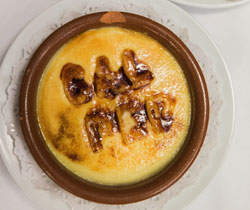 Alex explained that Catalonia was historically one of the poorer regions of Spain, so they learned to adopt all manner of seafood into their diets. These creative adaptations meant cuttlefish as well as squid cooked in its own ink – something especially well prepared at Cal Pep Restaurant on the Plaça de les Olles in the El Born neighborhood.
Alex explained that Catalonia was historically one of the poorer regions of Spain, so they learned to adopt all manner of seafood into their diets. These creative adaptations meant cuttlefish as well as squid cooked in its own ink – something especially well prepared at Cal Pep Restaurant on the Plaça de les Olles in the El Born neighborhood.
Having covered much of Barcelona in our first day, we decided to venture out of the city on day two and traveled by regional rail to the Montserrat monastery. Situated high atop the mountains of Catalonia, the monastery is surreal and begs the question, how did they build something so grand on the face of a cliff?
From the train, we took the gondola up the mountain side to the abbey. The ride offered unparalleled views of the mountains and further added to the wonder of the place. The monastery dates back to the early-eleventh century, but to our surprise much of the architecture appeared newer than expected. That’s because, we learned, much of the structure was destroyed by Napoleon’s troops in 1811 and has since been rebuilt.
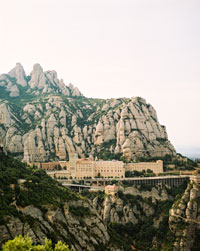
The highlight of our visit to Montserrat was a little hike we took on the road that curves to a separate mountain peak. It offered a scenic view looking out over the valley below and back at the monastery. The peaceful, picturesque setting perfectly complemented our busy time in the city the day before.
After descending the mountain, we had one final relaxed day of wandering through Barcelona’s shops and markets. One of our last stops was La Boqueria Market off of La Ramblas. Full of color, it had a seemingly limitless array of food. The displays of jamón (Spanish dry-cured ham) were especially impressive. It provided a lively final chapter – a last experience that spoke of the spirited life of its historic city.
Written by Stephen and Annie DeVries



